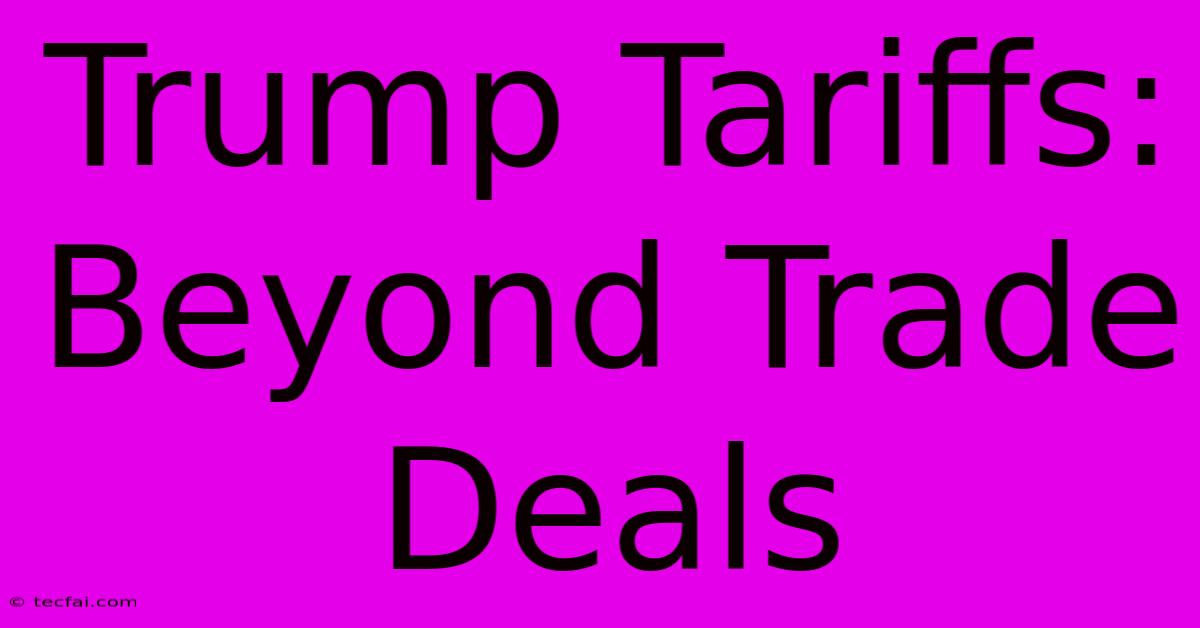Trump Tariffs: Beyond Trade Deals

Discover more detailed and exciting information on our website. Click the link below to start your adventure: Visit Best Website tecfai.com. Don't miss out!
Table of Contents
Trump Tariffs: Beyond Trade Deals – A Lasting Impact on the US Economy
The Trump administration's imposition of tariffs on various goods, a hallmark of its trade policy, sparked considerable debate and had far-reaching consequences extending beyond simple trade agreements. This article delves into the multifaceted impact of these tariffs, exploring their effects on different sectors, the broader economic landscape, and their lingering influence on US trade relations.
The Rationale Behind the Tariffs
The stated rationale behind the tariffs was to protect American industries from unfair foreign competition, particularly from China. The administration argued that these tariffs would level the playing field, encourage domestic manufacturing, and ultimately boost American jobs. Specific targets included steel and aluminum imports, alongside a wide range of Chinese goods, encompassing everything from consumer electronics to agricultural products. The administration framed these actions as necessary to address what it perceived as unfair trade practices, including intellectual property theft and subsidized industries.
Beyond the Official Narrative: Hidden Motives and unintended consequences
While the official narrative focused on economic fairness, analysts point to other potential factors motivating the tariff strategy. Some suggest the tariffs were intended to pressure China into negotiating more favorable trade deals, or even as a tool to exert political leverage. Regardless of intent, the consequences extended far beyond the initial projections.
The Economic Ripple Effect: Winners and Losers
The impact of the Trump tariffs wasn't uniform. While certain sectors, particularly those involved in steel and aluminum production, experienced a temporary boost, many others faced significant challenges. Farmers, for instance, bore the brunt of retaliatory tariffs imposed by China, leading to substantial losses and government bailout programs. Consumers also felt the pinch, as higher prices for imported goods led to increased inflation.
Examining Specific Sectors: A Case-by-Case Analysis
- Agriculture: The agricultural sector suffered immensely due to retaliatory tariffs imposed by China and other trading partners. Soybean and pork producers, particularly, experienced significant declines in exports.
- Manufacturing: While some domestic manufacturers benefited from increased demand due to higher import costs, many faced higher input costs, impacting their competitiveness.
- Retail: Consumers faced higher prices on a wide range of goods, dampening consumer spending and contributing to inflationary pressures.
The Long-Term Implications: A Shifting Global Landscape
The Trump tariffs left a lasting impact on the global trade landscape. The trade war with China, fueled by these tariffs, exacerbated existing tensions and led to a period of uncertainty in international markets. These actions also challenged the existing global trading system, raising questions about the future of multilateral trade agreements.
Geopolitical ramifications and lasting effects on trade relationships
Beyond the economic consequences, the Trump tariffs significantly strained US relationships with key trading partners. The retaliatory tariffs imposed by other countries damaged trust and fostered a more protectionist global environment. The long-term effects on international cooperation and trade negotiations remain to be seen.
Conclusion: A Complex Legacy
The Trump tariffs represent a complex and multifaceted policy with long-lasting consequences. While the intended goals of protecting American industries and boosting domestic manufacturing were partially achieved in some sectors, the overall economic impact remains a subject of ongoing debate. The tariffs' contribution to increased inflation, strained international relations, and a more protectionist global trade environment cannot be ignored. Understanding the full scope of their effects is crucial for navigating the evolving landscape of international trade and formulating future trade policies. Further research and analysis are needed to fully grasp the lasting legacy of this controversial trade initiative.

Thank you for visiting our website wich cover about Trump Tariffs: Beyond Trade Deals. We hope the information provided has been useful to you. Feel free to contact us if you have any questions or need further assistance. See you next time and dont miss to bookmark.
Featured Posts
-
Butterball Faces Video Backlash
Nov 27, 2024
-
Bonnie Blues Three Word Statement Divides Viewers
Nov 27, 2024
-
Citys Draw 3 Goal Lead Lost
Nov 27, 2024
-
Trump Tariffs Trade Impact On Mexico Canada China
Nov 27, 2024
-
Watch Bayern Vs Psg Live Stream And Odds
Nov 27, 2024
